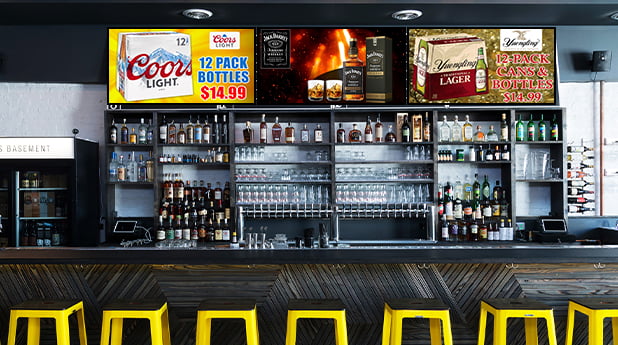In the bustling world of hospitality, where competition is fierce and first impressions are everything, signage plays a pivotal role. Restaurant and bar signage not only guides patrons to their destination but also sets the tone for their entire experience. From capturing attention to conveying brand identity and facilitating customer flow, effective signage is a critical component of any successful establishment. In this comprehensive guide, we delve into the intricacies of restaurant and bar signage, exploring its various types, best practices, and emerging trends.
Understanding the Importance of Signage
Signage serves as the face of a restaurant or bar, communicating essential information and enticing potential customers. A well-designed and strategically placed sign can attract attention, create anticipation, and even influence consumer behavior. Whether it’s a neon-lit sign beckoning passersby or an elegant logo adorning the entrance, signage shapes perceptions and fosters brand recognition.
Types of Restaurant and Bar Signage
- Exterior Signage: The first point of contact for customers, exterior signage should be eye-catching and informative. This includes storefront signs, window decals, sidewalk chalkboards, and outdoor banners. Clever use of typography, color, and imagery can entice pedestrians and draw them into the establishment.
- Interior Signage: Once inside, patrons rely on interior signage to navigate the space and make informed decisions. This includes menu boards, directional signs, restroom signs, and table markers. Clear, concise messaging is essential to ensure seamless customer flow and enhance the overall dining experience.
- Digital Signage: With advancements in technology, many restaurants and bars are embracing digital signage to deliver dynamic content and engage customers. Digital menu boards, interactive displays, and LED screens can showcase specials, promotions, and entertainment offerings in a visually compelling manner.
- Wayfinding Signage: In larger establishments or multi-level venues, wayfinding signage helps customers navigate complex layouts with ease. This includes floor plans, maps, and directional arrows strategically placed throughout the space. Intuitive wayfinding signage reduces confusion and enhances customer satisfaction.
- Branding Signage: Beyond providing information, signage also serves as a powerful branding tool. Consistent use of logos, colors, and design elements across all signage reinforces brand identity and fosters brand loyalty. Whether it’s a custom neon sign or a branded mural, unique and memorable signage can leave a lasting impression on customers.
Best Practices for Effective Signage
- Keep it Simple: In the age of information overload, simplicity reigns supreme. Avoid cluttered designs and excessive text, opting instead for clean layouts and concise messaging that is easy to read and understand at a glance.
- Prioritize Visibility: Signage must be visible from a distance and in various lighting conditions. Choose high-contrast colors, legible fonts, and appropriate sizing to ensure maximum visibility and readability.
- Maintain Consistency: Consistency is key to building a strong brand presence. Use consistent branding elements such as logos, colors, and fonts across all signage to reinforce brand identity and create a cohesive visual identity.
- Consider Location: The placement of signage is just as important as its design. Place exterior signage at eye level and in prominent locations to maximize visibility and attract foot traffic. Interior signage should be strategically placed to guide customers through the space without causing congestion.
- Invest in Quality: Quality signage reflects positively on the establishment and communicates professionalism and attention to detail. Invest in durable materials and craftsmanship to ensure longevity and maintain a polished appearance.
Emerging Trends in Restaurant and Bar Signage
- Interactive Experiences: As technology continues to evolve, interactive signage offers new opportunities for engagement and immersion. Touchscreen displays, augmented reality experiences, and QR code integration can enhance customer interaction and provide personalized recommendations.
- Sustainability: With growing awareness of environmental issues, sustainable signage options are gaining traction. Eco-friendly materials such as recycled wood, bamboo, and LED lighting not only reduce environmental impact but also appeal to eco-conscious consumers.
- Personalization: In an era of customization, personalized signage allows establishments to connect with customers on a deeper level. Digital signage platforms enable real-time updates and targeted messaging based on customer preferences and behavior.
- Artistic Expression: Beyond its practical function, signage is increasingly being recognized as an art form. Custom murals, hand-painted signage, and sculptural installations can transform a space and create a memorable visual experience for patrons.
- Integration with Social Media: In the age of social media, signage serves as a powerful tool for online promotion and user-generated content. Incorporating hashtags, social media handles, and interactive photo opportunities encourages patrons to share their experiences online, amplifying brand visibility and reach.
In conclusion, restaurant digital signage is far more than just a means of conveying information—it’s a powerful tool for communication, branding, and customer engagement. By understanding the different types of signage, adhering to best practices, and embracing emerging trends, establishments can create immersive experiences that leave a lasting impression on patrons and drive business success. Whether it’s a traditional storefront sign or a cutting-edge digital display, effective signage is essential for navigating the ever-evolving landscape of hospitality.



